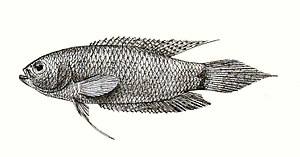Black pointed tail macropod
| Black pointed tail macropod | ||||||||||||
|---|---|---|---|---|---|---|---|---|---|---|---|---|

Black pointed tail macropod ( Pseudosphromenus cupanus ) |
||||||||||||
| Systematics | ||||||||||||
|
||||||||||||
| Scientific name | ||||||||||||
| Pseudosphromenus cupanus | ||||||||||||
| ( Cuvier , 1831) |
The black pointed tail macropod ( Pseudosphromenus cupanus ) is an Asian freshwater fish from the group of labyrinth fish (Anabantoidei), which occurs in southern India and Sri Lanka and possibly also in Bangladesh . The species is considered harmless.
features
The fish reach a length of 6.5 to 7.5 cm. They have an elongated body that is slightly flattened on the sides. The dorsal and anal fins are long and slightly drawn out at the end of the soft-rayed sections. The caudal fin ends in a point. The animals are very variable in color. A predominantly dark brown or lighter reddish color is combined with a greenish tinge, which is particularly evident on the head and the gill covers. In some populations, two or three dark longitudinal bands are visible on the sides of the body. The eyes are red. The pelvic fins are orange or red, the remaining fins are light gray with dark or bluish edges. The anal fin and the lower section of the caudal fin often show rows of red dots or are red around the edges. There is often a dark spot on the base of the caudal fin. Females become very dark, almost black, at the time of reproduction. Their unpaired fins are less pointed.
- Fins formula : dorsal XIV – XVII / 5–7, anal XVI – XIX / 9–11, pectoral 11–12, ventral I / 5.
- Scale formula : mLR: 29–32.
Way of life
The black pointed-tailed macropod lives in heavily overgrown and slow-flowing small rivers, ditches and rice fields near the coast and feeds on insects and zooplankton . For reproduction, the species builds a foam nest on the surface of the water, often under a leaf. During spawning, the male wraps around the female and the fish turn so that the female's belly is facing the surface of the water. In this way, up to 300 eggs are released within half an hour, which either remain on the anal fin of the male or sink. Males and females collect the whitish eggs with their mouths, apply a layer of fine air bubbles to them by chewing movements so that they become lighter, and then spit them into the foam nest. Every now and then the males build a second foam nest and transfer the eggs there. The larvae hatch after about 30 hours and the young fish leave the foam nest after three to six days and swim freely.
Systematics
The black pointed-tail macropod was first scientifically described in 1831 by the French naturalist Georges Cuvier under the name Polyacanthus cupanus . The Arian-Coupang River near Puducherry in India was given as a type location . In 1879 the pointed-tail macropod became a type of the genus Pseudosphromenus , which was introduced by the Dutch ichthyologist Pieter Bleeker . In addition to the black pointed-tailed macropod, the genus only includes the red pointed- tailed macropod ( Pseudosphromenus signata ) , which occurs in southern India .
supporting documents
- ↑ a b c Hans-Joachim Richter: The book of the labyrinth fish. Verlag J. Neumann-Neudamm, 1983, ISBN 3-7888-0292-8 , p. 61 u. 62.
- ^ Rahman, AKA, 1989. Freshwater fishes of Bangladesh. Zoological Society of Bangladesh. Department of Zoology, University of Dhaka.
- ↑ Pseudosphromenus cupanus in the endangered Red List species the IUCN 2011. Posted by: Abraham, R., 2010. Retrieved on November 5 of 2019.
- ↑ Günther Sterba : Freshwater fish of the world. 2nd Edition. Urania, Leipzig / Jena / Berlin 1990, ISBN 3-332-00109-4 , p. 867.
- ↑ Pseudosphromenus cupanus on Fishbase.org (English)
- ↑ Pseudosphromenus cupanus in the Catalog of Fishes (English)
- ↑ Pseudosphromenus in the Catalog of Fishes (English)
- ↑ Pseudosphromenus dayi on Fishbase.org (English)